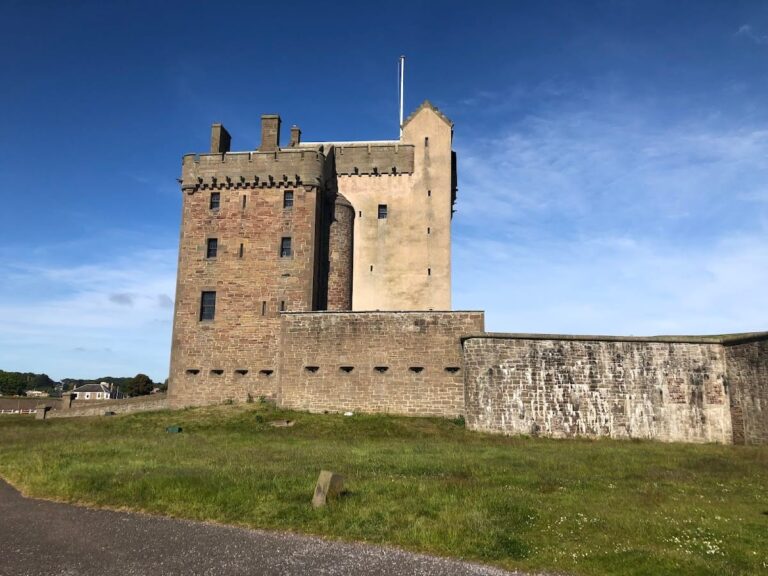Fingask Castle: A Historic Scottish Estate with Medieval Origins
Visitor Information
Google Rating: 4.6
Popularity: Low
Google Maps: View on Google Maps
Official Website: www.fingaskcastle.com
Country: United Kingdom
Civilization: Unclassified
Remains: Military
History
Fingask Castle is situated near the village of Rait in Scotland, constructed originally by medieval Scottish builders. Its early origins trace back to a fortification dating from the 12th century, around which the residence seen today was later developed.
The estate of Fingask first appears in historical records in the early 1100s, mentioned in the Foundation Charter of Scone Abbey granted by King Alexander I. By the 15th century, the lands belonged to the Bruce family, with Robert Bruce noted as the owner in 1484. This family held Fingask for several generations, maintaining control into the late 17th century. However, financial difficulties forced Laurence Bruce to sell the estate in 1671.
Shortly after, in 1672, Patrick Threipland acquired Fingask. He was instrumental in elevating the estate to baronial status the same year and carried out renovations that enhanced the house and its gardens. His services earned him a knighthood and, in 1687, the hereditary title of baronet of Nova Scotia. His son, Sir David Threipland, became involved in the Jacobite uprising of 1715, supporting the attempt to restore the Stuart monarchy. This allegiance led to the seizure of Fingask and the stripping away of the baronetcy rights.
Following this period, Fingask was held by the York Buildings Company until 1783, when Dr. Stuart Threipland, the half-brother of the Jacobite participant who died in the 1745 rising, repurchased the estate. The baronetcy was reinstated in 1826 for Sir Patrick Budge Murray Threipland. Over the years from 1828 to 1840, he undertook significant expansions to the castle, adding to its south and west sections.
In the 20th century, the property left the Threipland lineage in 1917 and became the possession of Sir John Henderson Stewart, a whisky merchant. Unfortunately, financial troubles forced a tragic end when he took his own life in 1924. The following year, H. B. Gilroy purchased Fingask, implementing substantial remodeling that altered certain features, including the removal of spiral staircases and 19th-century additions.
The castle returned to the Threipland family in 1969 under Mark Stepney Murray Threipland, though the estate had been reduced to roughly 30 hectares by then. In 1996, Andrew Murray Threipland took ownership. The site continues to hold cultural value, preserving its historical legacy within Scotland.
Remains
Fingask Castle is built around an original core dating to the 12th century, with the primary structure visible today established in 1592. The castle occupies elevated terrain about 60 meters above the surrounding area, granting extensive views over the Carse of Gowrie, the Firth of Tay, and Fife beyond. This strategic placement provides a commanding presence on the landscape.
The estate grounds include formal gardens notable for their carefully shaped topiary, illustrating the skill involved in their maintenance. Among the garden buildings is The Pavilion, designed as a charming structure for social gatherings such as weddings and events, adding a picturesque element to the estate.
A remarkable aspect of the gardens is the collection of statues created by the Perth sculptor David Anderson. These figures portray characters drawn from prominent Scottish literary works, featuring references to Alexander Wilson, Robert Burns, and Sir Walter Scott. Supplementing these are sculptures such as a nude black figure of Doryphoros, a life-size statue of William Pitt the Younger, and various smaller pieces by Charles Spence, who was both a local bard and mason connected to the Threipland family.
The landscape also preserves several historical features, including a medieval baptismal font, a sundial, and a well, all of which hold Category B listed status for their architectural and cultural importance. A bridge spanning the nearby Craig Burn is registered as a Category C listed monument, emphasizing its significance in the overall layout of the estate.
Another historic centerpiece is the Perth mercat cross, a symbolic stone cross originally located in Perth city center. This has been relocated around 1660 to the grounds of Fingask, marking an important piece of civic history now incorporated into the castle’s setting.
In the 20th century, the house underwent extensive remodeling, which included the removal of spiral staircases and the demolition of the frontal additions constructed in the 19th century. These renovations reduced some of the later architectural elements but preserved the castle’s medieval and early modern core fabric, maintaining its character and historical integrity.









